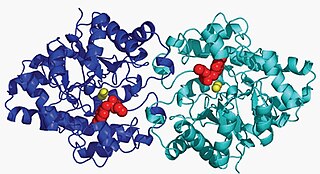Related Research Articles

Microcystins—or cyanoginosins—are a class of toxins produced by certain freshwater blue-green algae. Over 50 different microcystins have been discovered so far, of which microcystin-LR is the most common. Chemically they are cyclic heptapeptides produced through nonribosomal peptide synthases.

Aspergillus flavus is a saprotrophic and pathogenic fungus with a cosmopolitan distribution. It is best known for its colonization of cereal grains, legumes, and tree nuts. Postharvest rot typically develops during harvest, storage, and/or transit. Its specific name flavus derives from the Latin meaning yellow, a reference to the frequently observed colour of the spores. A. flavus infections can occur while hosts are still in the field (preharvest), but often show no symptoms (dormancy) until postharvest storage and/or transport. In addition to causing preharvest and postharvest infections, many strains produce significant quantities of toxic compounds known as mycotoxins, which, when consumed, are toxic to mammals. A. flavus is also an opportunistic human and animal pathogen, causing aspergillosis in immunocompromised individuals.

Dadiah (Minangkabau) or dadih (Indonesian) a traditional fermented milk popular among people of West Sumatra, Indonesia, is made by pouring fresh, raw, unheated, buffalo milk into a bamboo tube capped with a banana leaf and allowing it to ferment spontaneously at room temperature for two days.

Aryldialkylphosphatase is a metalloenzyme that hydrolyzes the triester linkage found in organophosphate insecticides.
Microcystinase is a protease that selectively degrades Microcystin, an extremely potent cyanotoxin that results in marine pollution and human and animal food chain poisoning. The enzyme is naturally produced by a number of bacteria isolated in Japan and New Zealand. As of 2012, the chemical structure of this enzyme has not been scientifically determined. The enzyme degrades the cyclic peptide toxin microcystin into a linear peptide, which is 160 times less toxic. Other bacteria then further degrade the linear peptide.
Xanthobacter flavus is a Gram-negative, nitrogen-fixing and facultatively autotrophic bacteria from the family of Xanthobacteraceae which has been isolated from turf podsol soil in Russia. Xanthobacter flavus has the ability to degrade phenol, oxalate and 1,4-dichlorobenzene.
Isoptericola jiangsuensis is a Gram-positive, chitin-degrading and non-motile bacterium from the genus of Isoptericola which has been isolated from beach soil near Lianyungang in China.
Mucilaginibacter is a genus from the family of Sphingobacteriaceae.
Mariniluteicoccus is a bacterial genus from the family of Propionibacteriaceae.
Mariniluteicoccus flavus is a Gram-positive, aerobic and non-motil bacterium from the genus of Mariniluteicoccus which has been isolated from deep-sea sediment from the South China Sea in China.
Roseomonas oryzae is a species of Gram negative, strictly aerobic, coccobacilli-shaped, pale pink-colored bacterium. It was first isolated from rice paddy rhizosphere soil in Western Ghats, Kankumbi, India. The species name is derived from Latin oryzae.
Roseomonas rhizosphaerae is a species of Gram negative, strictly aerobic, coccobacilli-shaped, pink-colored bacterium. It was first isolated from soil under long-term application of triazofos in Yangzhou, Jiangsu province, China, and the species was first proposed in 2011. The species name refers to the rhizosphere from which it was first isolated.
Steroidobacter is a genus of bacteria from the family of Sinobacteraceae.
Steroidobacter agariperforans is a Gram-negative, aerobic, non-spore-forming and non-motile bacterium from the genus of Steroidobacter.
Steroidobacter denitrificans is a Gram-negative and motile bacterium from the genus of Steroidobacter which has been isolated from anoxic sewage sludge from Soers in Germany. Steroidobacter denitrificans has the ability to degrade steroid hormones.
Solimonas flava is a Gram-negative, rod-shaped and non-motile bacterium from the genus of Solimonas which has been isolated from polluted soil from Jiangsu in China.
Stenotrophomonas acidaminiphila is a strictly aerobic, Gram-negative, mesophilic, non-spore-forming and motile bacterium from the genus of Stenotrophomonas which has been isolated from industrial waste water in Mexico. Stenotrophomonas acidaminiphila can degrade polycyclic aromatic hydrocarbons.
Falsirhodobacter is a genus of bacteria from the family of Rhodobacteraceae.
Agromyces flavus is a Gram-negative, aerobic and non-motile bacterium from the genus of Agromyces which has been isolated from soil from the Tibetan Plateau in China.
Flaviaesturariibacter flavus is a Gram-negative and non-motile bacterium from the genus of Flaviaesturariibacter which has been isolated from soil from the Jeju Island in Korea.
References
- 1 2 "Steroidobacter flavus". www.uniprot.org.
- ↑ Gong, ZL; Zhang, CF; Jin, R; Zhang, YQ (August 2016). "Steroidobacter flavus sp. nov., a microcystin-degrading Gammaproteobacterium isolated from soil". Antonie van Leeuwenhoek. 109 (8): 1073–9. doi:10.1007/s10482-016-0706-5. PMID 27151048. S2CID 14654172.
- ↑ "Taxonomy Browser". www.ncbi.nlm.nih.gov.
| | This Gammaproteobacteria-related article is a stub. You can help Wikipedia by expanding it. |